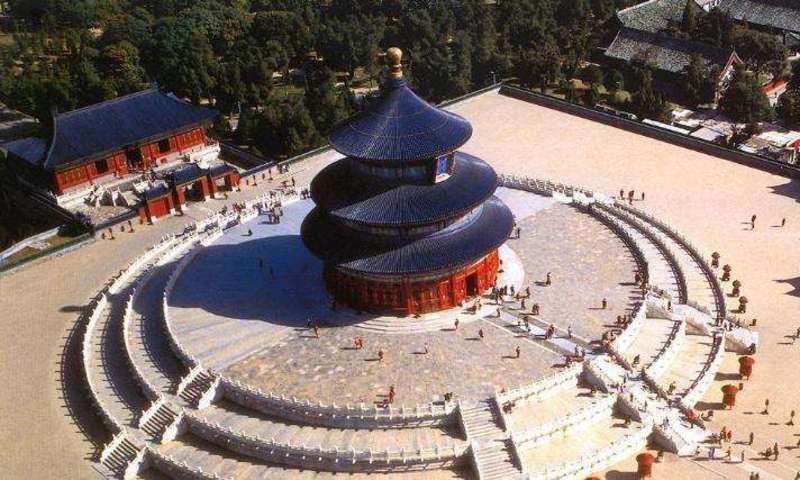Temple of Heaven

The Xuanqiu altar in the Temple of Heaven in Beijing is a place for worshipping the heavens in ancient times, which consists of the upper, middle and lower layers, from inwards to outwards.
In the center of the upper layer is a circular slab (called the center stone). 9 fan-shaped slabs are built around the center stone to form the first ring. Each ring increases by 9 pieces of slabs outwards in each layer. The first ring of the next layer also has 9 pieces of slabs more than the last ring of the previous layer.
Knowing that the number of rings in each layer is the same, and the lower layer has 7 2 9 pieces of slabs more than the middle layer, how many slabs are there in the three layers (excluding the center stone)?
Source: Gaokao 2020, II
The answer is 3402.
This section requires Javascript.
You are seeing this because something didn't load right. We suggest you, (a) try
refreshing the page, (b) enabling javascript if it is disabled on your browser and,
finally, (c)
loading the
non-javascript version of this page
. We're sorry about the hassle.
2 solutions
Side note: It's interesting to know that since 9 is a noble number in China, which represents Yang, it makes sense to have 9 rings for each layer, as a check. Anyway, it's a good word problem in Gaokao, and it needs patience in such a short time :)
Let the number of rings in a layer be n . Then there is a total of 3 n rings. Numbering the rings from 1 to 3 n from the first ring of upper layer to the last ring of lower layer. We note that the numbers of slabs in a ring are in an arithmetic progression , where the k th term or the number of slabs in k th ring is a k = 9 k .
Then the number of slabs in the middle layer, S 2 = k = n + 1 ∑ 2 n a k = 2 n ( a n + 1 + a 2 n ) = 2 9 n ( 3 n + 1 ) .
Similarly, the number of slabs in the lower layer, S 3 = k = 2 n + 1 ∑ 3 n a k = 2 n ( a 2 n + 1 + a 3 n ) = 2 9 n ( 5 n + 1 ) .
Given that S 3 − S 2 = 7 2 9 , ⟹ 2 9 n ( 5 n + 1 ) − 2 9 n ( 3 n + 1 ) = 9 n 2 = 7 2 9 ⟹ n = 9 ( Should of thought of it. ).
Then the total number of slabs in the three layers S = k = 1 ∑ 2 7 a k = 2 2 7 × 9 ( 1 + 2 7 ) = 3 4 0 2 .
The rings are in an arithmetic progression, so the first layer has a sum of L 1 = S n = 2 1 ( 9 n 2 + 9 n ) slabs for n rings in its layer.
The first and second layers have a sum of L 1 + L 2 = S 2 n = 2 1 ( 9 ( 2 n ) 2 + 9 ( 2 n ) ) slabs for n rings in each layer, so the second layer alone has L 2 = ( L 1 + L 2 ) − L 1 = S 2 n − S n = 2 1 ( 9 ( 2 n ) 2 + 9 ( 2 n ) ) − 2 1 ( 9 n 2 + 9 n ) slabs.
The first, second, and third layers have a sum of L 1 + L 2 + L 3 = S 3 n = 2 1 ( 9 ( 3 n ) 2 + 9 ( 3 n ) ) slabs for n rings in each layer, so the third layer alone has L 3 = ( L 1 + L 2 + L 3 ) − ( L 1 + L 2 ) = S 3 n − S 2 n = 2 1 ( 9 ( 3 n ) 2 + 9 ( 3 n ) ) − 2 1 ( 9 ( 2 n ) 2 + 9 ( 2 n ) ) slabs.
The difference between the third and second layer is 7 2 9 , so L 3 − L 2 = ( 2 1 ( 9 ( 3 n ) 2 + 9 ( 3 n ) ) − 2 1 ( 9 ( 2 n ) 2 + 9 ( 2 n ) ) ) − ( 2 1 ( 9 ( 2 n ) 2 + 9 ( 2 n ) ) − 2 1 ( 9 n 2 + 9 n ) ) = 9 n 2 = 7 2 9 , which solves to n = 9 for n > 0 .
There are therefore n = 9 rings per layer, for a total of S 3 n = 2 1 ( 9 ( 3 n ) 2 + 9 ( 3 n ) ) = 2 1 ( 9 ( 3 ⋅ 9 ) 2 + 9 ( 3 ⋅ 9 ) ) = 3 4 0 2 slabs.